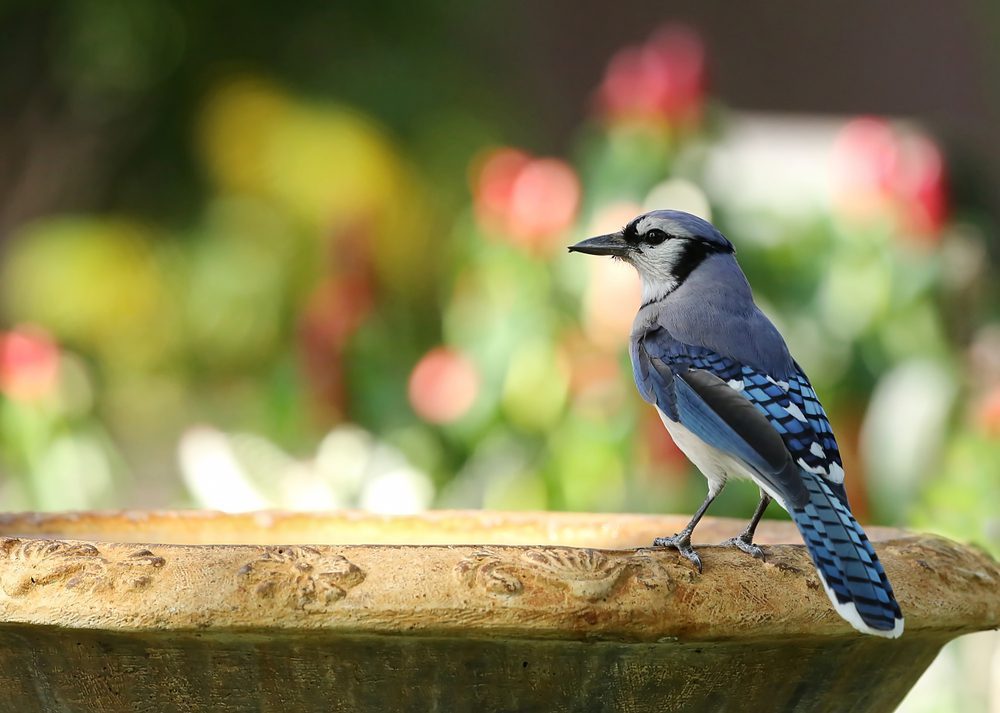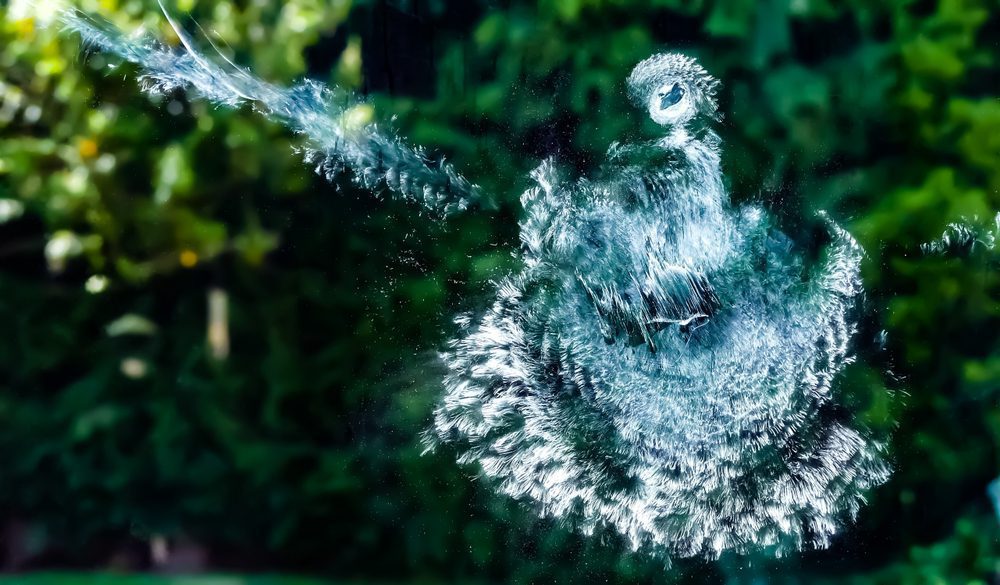Are you a passionate birdwatcher or someone who appreciates the beauty of nature? If so, get ready to be amazed as we unveil the top 15 common backyard birds in this blog. Picture yourself in the tranquility of your backyard, surrounded by the sweet melodies and vibrant colors of these magnificent creatures.
Have you ever wondered which birds are most likely to visit your backyard? Which ones are known for their unique behaviors or striking plumage? In this article, we will dive into the world of backyard birdwatching and uncover the fascinating details of the top 15 birds you may encounter.
From the cheerful American Robin to the elusive Northern Cardinal, we’ll explore each bird’s distinctive characteristics, habitat, feeding habits, and interesting facts. Whether you’re a beginner or an experienced birder, this article aims to provide valuable insights into these feathered friends that will enhance your birdwatching experience.
Table of Contents
What Makes a Bird Common?
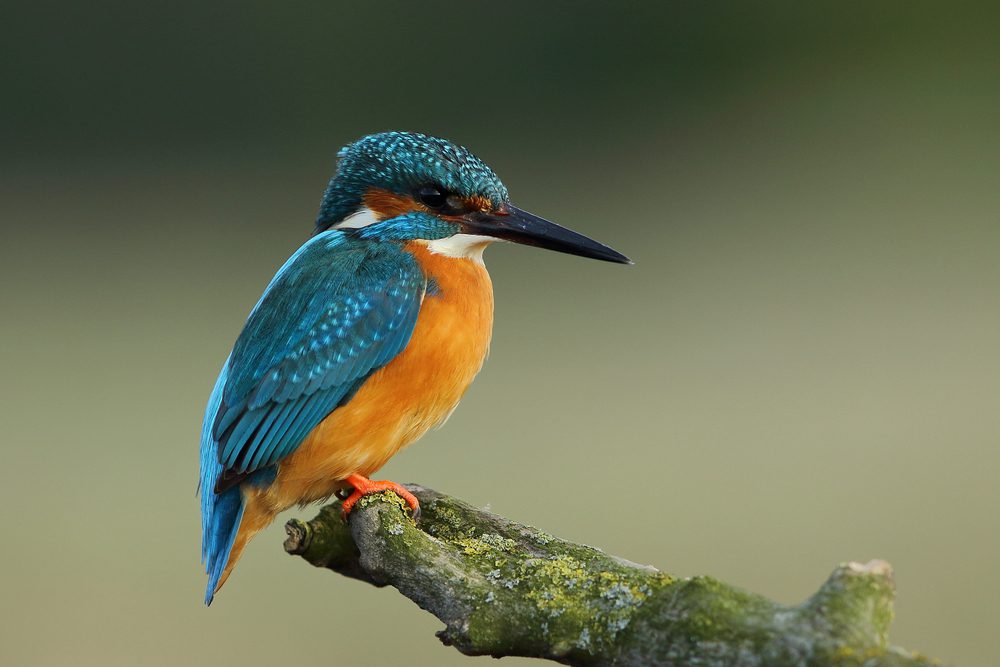
When it comes to identifying common birds, birdwatchers understand that there are certain characteristics that make a bird widespread and easily recognizable. Understanding what makes a bird common can help bird enthusiasts identify and appreciate the most frequently encountered avian visitors in their backyard. Let’s explore the key factors that contribute to a bird’s commonness.
1. Abundance and Distribution:
Common birds are typically found in large numbers and have a wide geographical range. They are abundant and can be spotted in various habitats across North America. These birds have adapted well to diverse environments, from forests to urban areas, and are versatile in their diet and nesting requirements.
2. Adaptability and Generalist Nature:
Common backyard birds often possess a generalist nature, which means they can thrive in different habitats and consume a wide range of food sources. This adaptability helps them successfully navigate various ecosystems and survive in both urban and rural settings. They are not highly specialized and can easily find suitable nesting sites and food resources.
3. Tolerance to Human Presence:
One of the reasons certain birds are common is their ability to tolerate human activity. They can adapt to and utilize the resources provided by human-altered landscapes, such as bird feeders and nesting boxes. This tolerance allows them to coexist and thrive in close proximity to humans, making them a familiar sight in residential areas.
4. Ecological Dominance:
Some common birds have achieved a level of ecological dominance due to their competitive advantage over other species. They may outcompete less adaptable or specialized birds for resources, leading to their widespread presence. Their ability to exploit available niches and resource availability may contribute to their commonness.
5. Attractive Traits:
Some birds are really liked by people because they have bright feathers, sing nicely, or act in interesting ways. Birdwatchers often prefer these kinds of birds. Because these birds get more attention, people think they are more common than they might actually be.
“The factors that contribute to a bird’s commonness include its abundance, adaptability, tolerance to humans, ecological dominance, and attractive traits. Understanding these features can help birdwatchers appreciate and identify the most frequently encountered avian visitors in their backyard.”
💡 key Takeaway: The commonness of a bird is influenced by factors such as its abundance, adaptability, tolerance to human presence, ecological dominance, and attractive traits.
1. Black-capped Chickadee
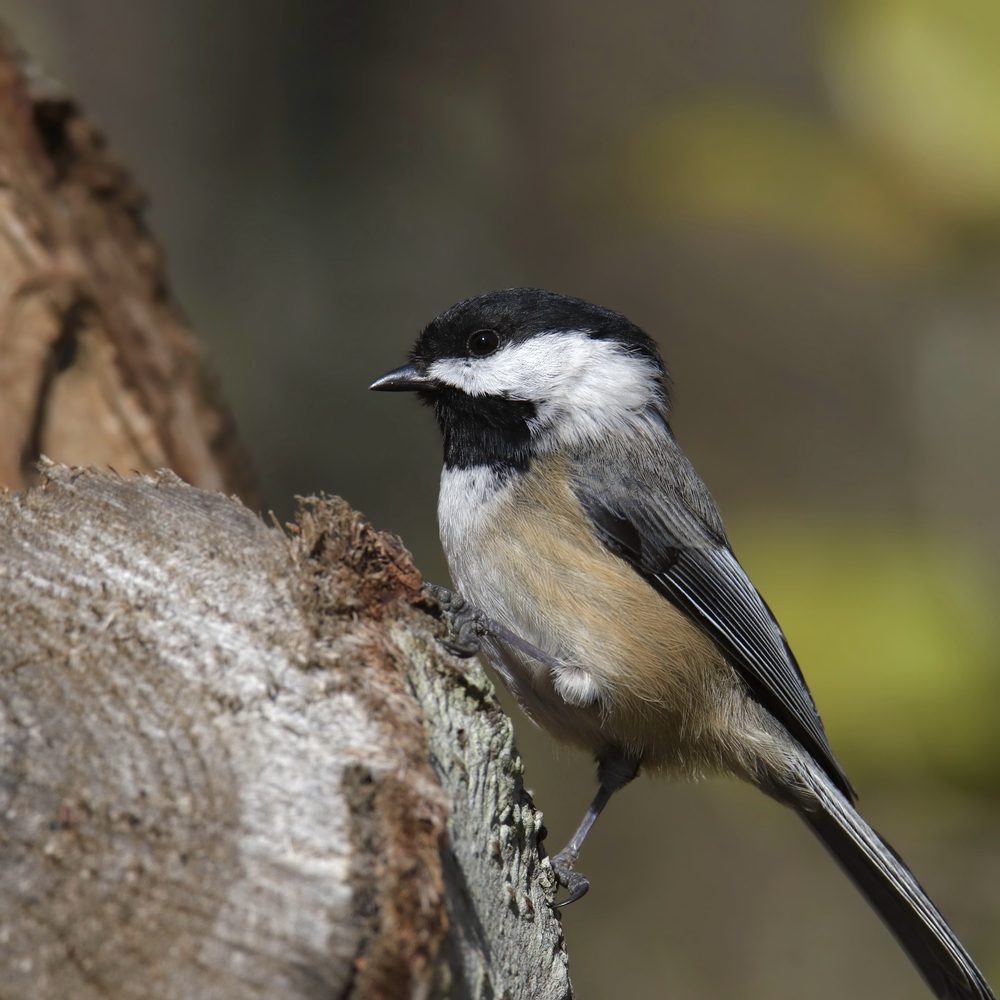
The Black-capped Chickadee (Poecile atricapillus) is a small bird that can be commonly found in North America. With its distinctive black cap and white cheeks, this charming little bird is a favorite among birdwatchers. Here’s everything you need to know about the Black-capped Chickadee.
Appearance:
The Black-capped Chickadee measures around 11 to 14 centimeters in length, making it one of the smaller bird species. It has a black cap and throat, with white cheeks and a white belly. Its wings and back are greyish-brown in color. One of its most notable features is its bold black eye mask, which adds to its adorable appearance.
Habitat and Distribution:
The Black-capped Chickadee can be found across North America, from Alaska and Canada to the United States. It prefers habitats such as deciduous and mixed forests, forest edges, and parks with mature trees. It is also known to adapt well to suburban areas.
Behavior and Diet:
These social birds are often seen in small flocks, foraging for their food together. They have a varied diet that includes insects, seeds, berries, and even small fruits. They are particularly fond of sunflower seeds and can often be spotted at bird feeders. Black-capped Chickadees are known for their acrobatic maneuvers as they hang upside down to eat from cones or to inspect tree bark for insects.
Vocalizations:
This species produces a characteristic “chick-a-dee-dee-dee” call that serves as its namesake. The number of “dee” notes in the call can vary depending on the situation and potential threats. Besides their well-known call, Black-capped Chickadees have a repertoire of various whistles, trills, and songs, which they use to communicate with their flock mates.
Conservation Status:
The Black-capped Chickadee is not considered globally threatened and is categorized as a species of least concern. Its adaptable nature and ability to thrive in various habitats contribute to its stable population.
💡 key Takeaway: The Black-capped Chickadee is a small bird with a black cap and white cheeks, commonly found in North America. It prefers habitats such as forests, forest edges, and parks with mature trees. Known for their acrobatic foraging behavior and distinctive vocalizations.
2. Blue Jay

When it comes to common backyard birds, few can compare to the striking beauty and charismatic nature of the Blue Jay. With its vibrant blue plumage, white belly, and distinctive black head, Blue Jays are easily recognizable and a favorite among birdwatchers. Let’s explore more about this fascinating creature.
Appearance and Characteristics:
Blue Jays belong to the Corvidae family, which includes crows and ravens. They are medium-sized birds, measuring about 9-12 inches in length. The most striking feature of the Blue Jay is its vibrant blue feathers, which span across its wings, back, and tail. The contrasting white underside and black head create a striking visual appeal.
One of the Blue Jay’s most distinctive characteristics is its black eye mask, which extends across the face like a bandit’s mask. This, along with its black wings, creates a unique contrast against the bright blue plumage. Blue Jays are known for their loud and varied vocalizations. Their calls can range from a piercing scream to a melodic song, often mimicking other bird species. You can another article about blue jay in here
Habitat and Behavior:
Blue Jays are native to North America, primarily found in forests, woodland edges, and open areas. They are highly adaptable and can be spotted in residential neighborhoods, parks, and gardens. These birds are known for their love of acorns, and they can often be seen collecting and caching acorns for later consumption. Their habit of burying acorns helps in seed dispersal, making them essential agents of forest regeneration.
Blue Jays are omnivorous, feeding on a wide variety of foods, including insects, nuts, berries, fruits, seeds, and even small vertebrates. They are regular visitors to bird feeders, especially for sunflower seeds and suet.
Interesting Facts:
1. Despite their beauty, Blue Jays often face mixed perceptions. Some people appreciate their stunning appearance and intelligence, while others view them as aggressive due to their behavior when defending their nests from potential threats.
2. Blue Jays are highly intelligent birds and have been observed using tools to obtain food, such as using their beaks to pry open nuts or manipulatiing objects to reach their desired food source.
3. These birds are capable of mimicking the calls of other bird species and even some human-made sounds, adding to their repertoire of vocalizations.
3. American Robin
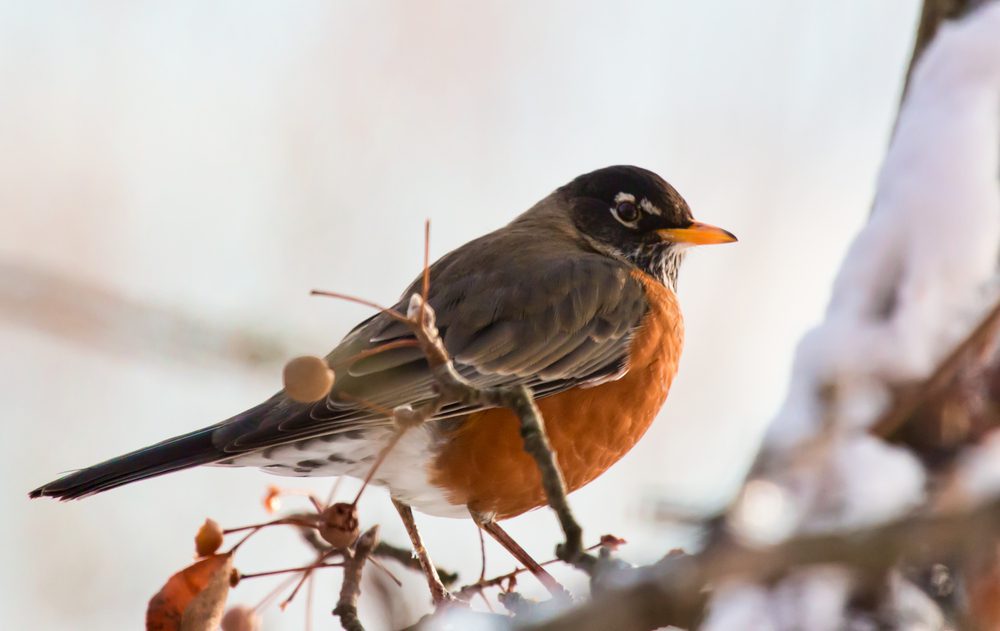
American Robin (Turdus migratorius) is a Common Backyard Bird with Song and Beauty
The American Robin is one of the most recognizable and beloved birds found in North America. With its striking appearance and melodic song, this species brings joy and beauty to backyards across the United States. Let’s explore some fascinating facts about the American Robin and why it is a frequent visitor to many gardens.
Appearance and Identification:
The American Robin is a medium-sized songbird, measuring about 9-11 inches in length. It has a distinctive black head and eye mask, complemented by a reddish-orange breast and throat. The robin’s upperparts are dark gray or black, while its underparts are a vibrant white. In flight, the white tips of its outer tail feathers create an eye-catching flash of white against its black wings.
Habitat and Distribution :
American Robins thrive in a variety of habitats, including open lawns, gardens, parks, forests, and woodland edges. They are native to North America and breed throughout the continent, ranging from Alaska and Canada to parts of Mexico. While they can be found year-round in some regions, others experience their arrival during spring and summer. American Robins are known for their adaptability and can be spotted in both urban and rural settings.
Behavior and Diet :
These birds are most active during daylight hours, foraging on the ground to find insects, earthworms, berries, and fruit. American Robins may also visit platform feeders in search of mealworms or enjoy a small selection of fruits such as chopped apples or berries. To attract American Robins to your backyard, consider planting native shrubs and trees that produce berries or providing a fresh water source. They are particularly attracted to areas with open spaces and ample vegetation, where they can build their nests and feed their young.
Nesting and Reproduction :
American Robins build their nests using a combination of mud, straw, twigs, and grass, creating a cup-like structure. These nests are often placed in the crotch.
4. Downy Woodpecker
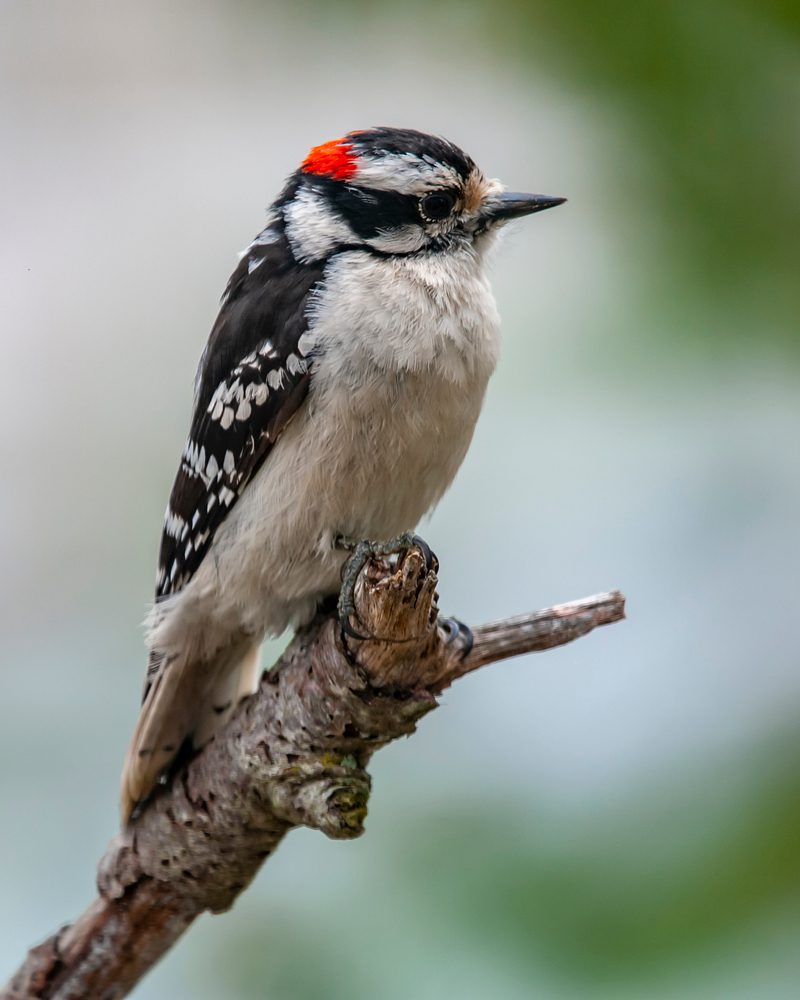
The Downy Woodpecker (Picoides pubescens) is a charming and charismatic bird that frequents many North American backyards. With its distinctive markings and playful behavior, this small bird is a favorite among birdwatchers. Let’s explore the fascinating characteristics and habits of the Downy Woodpecker.
Physical Appearance and Identification:
The Downy Woodpecker measures about 6-7 inches in length, making it the smallest woodpecker species in North America.
It features a black and white color pattern, with a black cap on its head and a white belly. The male Downy Woodpecker has a small red patch on the back of its head, while the female lacks this feature.
One of its most prominent features is its short and chisel-like bill, ideal for drilling and excavating insects from trees.
Downy or Hairy?: The Downy Woodpecker can sometimes be confused with the Hairy Woodpecker due to their similar appearance. However, the Downy Woodpecker has a shorter bill, a smaller overall size, and its outer tail feathers lack white spots found on the Hairy Woodpecker.
Habitat and Range:
These woodpeckers are highly adaptable and can be found in various habitats, including open woodlands, parks, gardens, and even urban areas. They have a particular affinity for deciduous trees, where they search for insects and build their nests. The Downy Woodpecker is a year-round resident throughout most of the United States and Canada. Its range extends from southern Alaska and Canada down to Mexico, covering almost all of North America.
Behaviors and Feeding Habits:
Like other woodpecker species, the Downy Woodpecker primarily forages by clinging to tree trunks and branches. It uses its bill to drum on the bark and excavate small crevices in search of insects, larvae, and eggs. Dietary Preferences: While insects make up a significant portion of their diet, Downy Woodpeckers also consume seeds, berries, and sap. They particularly enjoy feeding on suet and can frequently be seen visiting suet feeders in backyards.
5. Dark-eyed Junco
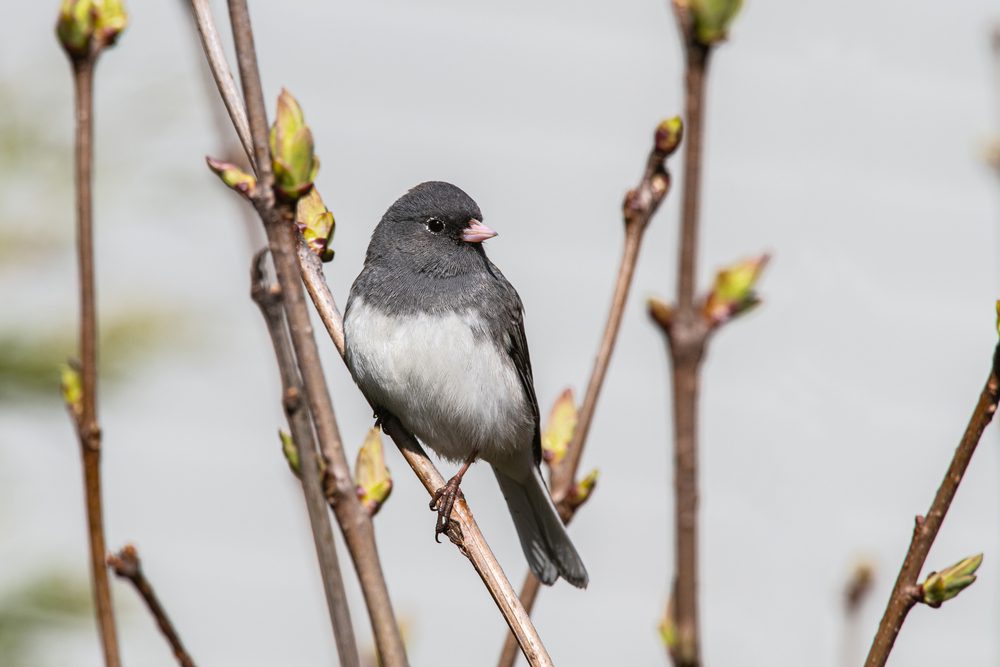
Dark-eyed Junco: The Beloved Backyard Visitor
The Dark-eyed Junco, a small bird native to North America, is a common sight in many backyard gardens and bird feeders. With its distinctive characteristics and charming behavior, it has become a favorite among birdwatchers across the United States.
Appearance and Behavior:
The Dark-eyed Junco is a small bird, measuring about 5-6 inches in length. It has a gray or brown upper body with a white belly, giving it a striking contrast. Some sub-species may have variations in color, such as the “Slate-colored” Junco with a darker gray plumage. One of the most recognizable features of the Dark-eyed Junco is its pinkish bill and legs, contrasting beautifully with its plumage. These birds are known for their ground-feeding habits. They often hop along the ground in search of seeds and insects, making them a frequent visitor to backyard feeders.
Habitat and Range:
Dark-eyed Juncos prefer woodland areas, forest edges, and open spaces with dense vegetation. They can also adapt well to urban environments, making them a common bird in both rural and suburban areas. They can be found across North America, with different sub-species occupying specific regions. For example, the “Oregon” Junco is prevalent in the western part of the continent, while the “White-winged” Junco is found in the northern areas.
Diet and Feeding:
Dark-eyed Juncos primarily feed on seeds, especially from plants such as sunflowers and native grasses. They are often seen foraging on the ground or perched on a platform feeder, pecking at the seeds. While seeds make up a significant part of their diet, Dark-eyed Juncos also consume insects, especially during the breeding season when they need to provide adequate nutrition for their young.
Conservation and Protection:
The Dark-eyed Junco’s striking appearance and entertaining behavior have made it a beloved bird among birdwatchers, contributing to its conservation and protection efforts. Importance of Native Plants: Providing a diverse range of native plants in your backyard can attract Dark-eyed Juncos and support their feeding habits, creating a more natural and sustainable environment for these birds.
6. Ruby-throated Hummingbird
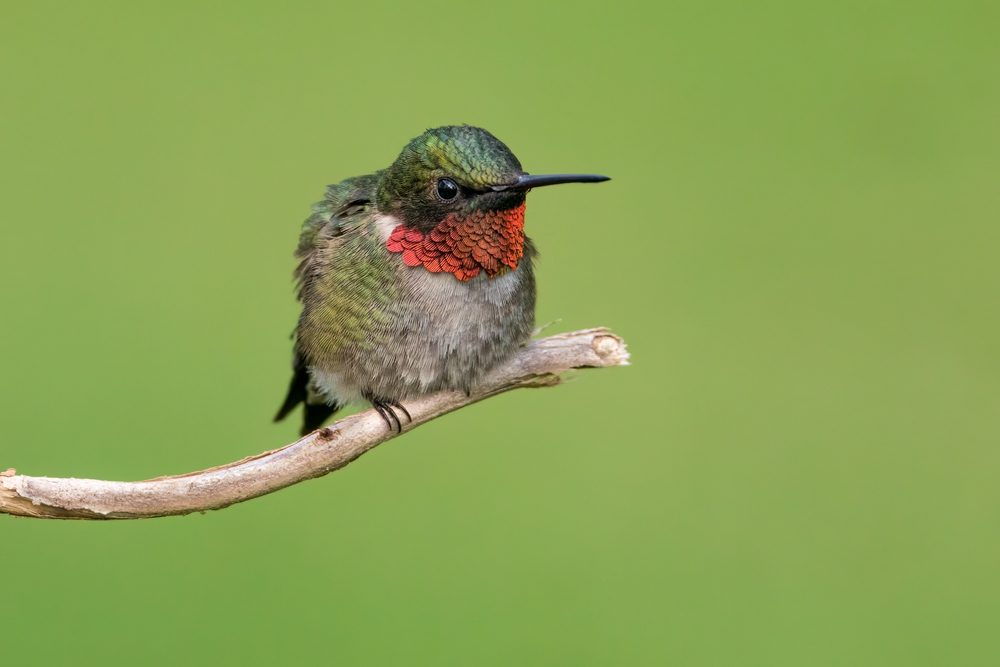
The Ruby-throated Hummingbird is a small bird known for its vibrant colors and remarkable flying abilities. This migratory bird is a true marvel of nature and a favorite among birdwatchers.
Appearance :
The Ruby-throated Hummingbird measures approximately 3 to 4 inches in length, making it one of the smallest bird species in North America.
The male of the species boasts a brilliant iridescent green plumage on its back and wings, while the female has a duller green coloration. As the name suggests, the male Ruby-throated Hummingbird features a stunning ruby-red throat patch, or gorget, which shines brightly in direct sunlight. Both males and females have long, slender bills perfectly adapted for sipping nectar from flowers, their primary source of food.
Habitat and Range :
Ruby-throated Hummingbirds are found in North America, particularly in the eastern and central regions of the United States. They have a wide range, from as far north as Canada to as far south as Central America during their migratory journeys. These birds prefer habitats that offer a mix of deciduous and coniferous trees, flowering plants, and open spaces.
Behavior and Diet :
Ruby-throated Hummingbirds are known for their incredible agility and speed. They can flap their wings up to 70 times per second, enabling them to hover in mid-air and even fly backward. Their diet primarily consists of nectar from various flowers, which they extract using their long bills and specialized tongues. They also consume small insects and spiders for additional protein. During migration, these birds cover impressive distances, fueled by their energy reserves and the abundant nectar sources along their routes.
Attracting Ruby-throated Hummingbirds :
Planting native flowering plants, such as trumpet vines, bee balm, and cardinal flowers, can attract Ruby-throated Hummingbirds to your backyard. Providing a hummingbird feeder filled with a solution of water and sugar (no food coloring) can supplement their natural nectar sources. It’s important to clean and refill the feeder regularly to prevent the growth of harmful bacteria and mold.
Interesting Fact :
The Ruby-throated Hummingbird is the only species of hummingbird that breeds in eastern North America.
7. Northern Cardinal
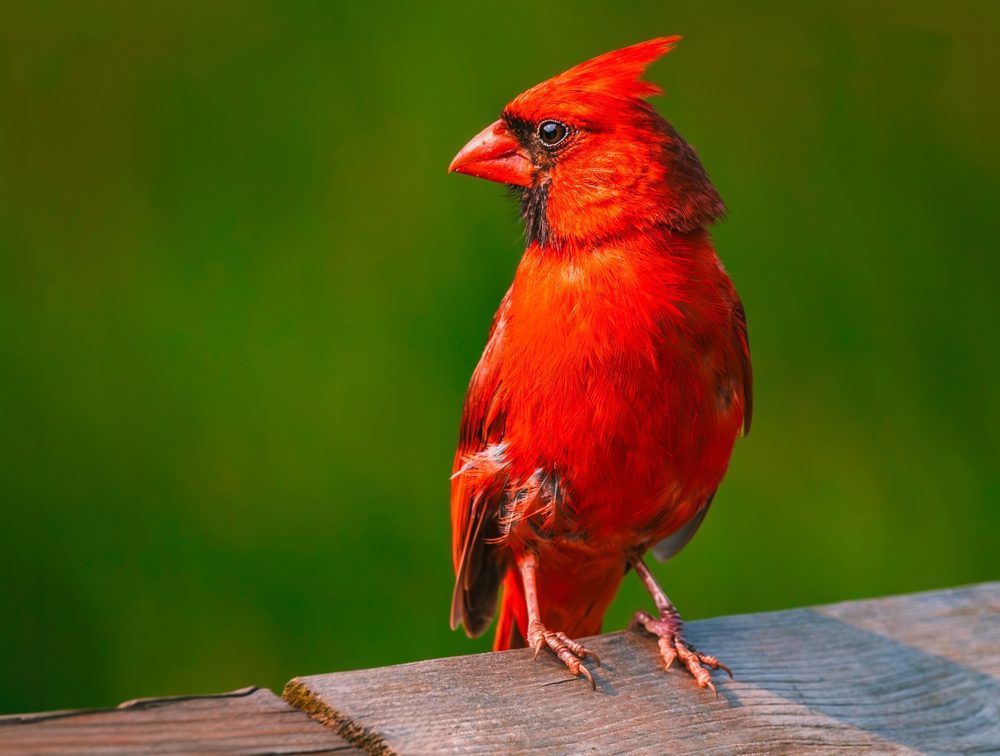
The Northern Cardinal (Cardinalis cardinalis) is one of the most iconic and beloved backyard birds in North America. With its vibrant red plumage and distinctive crest, this small bird easily captures the attention and admiration of birdwatchers of all levels of expertise.
Identification and Characteristics:
The male Northern Cardinal is known for its bright red feathers, black face mask, and prominent crest. Females, on the other hand, have a more subtle combination of grayish-brown feathers with touches of red. Both sexes have thick, orange-red beaks.
Cardinals are classified as medium-sized birds, with males typically measuring around 8-9 inches (20-23 cm) in length, including their long, fan-shaped tail. Females are slightly smaller.
Habitat and Distribution:
These birds are native to North America and can be found across a wide range of habitats, including forests, woodlands, gardens, and parks. They are known to prefer areas with dense shrubbery and trees that provide shelter and nesting sites. Northern Cardinals primarily feed on seeds, berries, and insects. They have a strong preference for sunflower seeds and are often seen at bird feeders, especially those containing black oil sunflower seeds.
Behavior and Vocalization:
The Northern Cardinal is known for its beautiful melodic song, which consists of a series of whistles, chirps, and trills. Both males and females sing, and their songs serve various purposes such as territorial defense and mate attraction. Cardinals are monogamous birds, with pairs typically staying together for multiple breeding seasons. The female builds the nest, which is a cup-shaped structure made of twigs, grass, and other plant materials. Nests are usually hidden within dense shrubs or low tree branches.
Males are particularly territorial and will vigorously defend their chosen nesting locations, often displaying aggressive behavior towards intruding birds, including their own reflections in windows.
Conservation and Human Interaction:
The Northern Cardinal holds special symbolism in many cultures, representing qualities such as hope, joy, and loved ones passed. Its bright red plumage has also made it a popular subject of artwork and photography. Providing a welcoming habitat for Northern Cardinals in your backyard can be as simple as offering a platform feeder with black oil sunflower seeds
8. House Sparrow

The House Sparrow (Passer domesticus) is a common bird species found throughout North America. With its small size and distinctive features, it is easily recognizable and frequently spotted in urban and suburban areas. Let’s explore more about this fascinating bird!
Appearance:
The House Sparrow is a small bird, measuring about 5-6 inches in length. It has a plump body with short wings and a short tail. Male House Sparrows have a gray crown, black throat, and chestnut-colored nape. They also have a white cheek patch. Females have a more subdued appearance, with brown feathers overall and pale stripes on the wings.
Habitat and Distribution:
House Sparrows are non-native birds that were introduced to North America from Europe in the 19th century. They have adapted well to human settlements and can be found in a variety of habitats, including parks, gardens, farmlands, and urban areas. These birds are highly adaptable and can thrive in both rural and urban environments.
Behavior and Diet:
House Sparrows are social birds that typically gather in large flocks or colonies. They are opportunistic feeders and have a varied diet, including seeds, grains, fruits, insects, and scraps. They are often seen foraging on the ground or at bird feeders. These birds are known to be aggressive towards other bird species, competing for resources and nesting sites.
Nesting and Reproduction:
House Sparrows build nests in various locations, such as tree cavities, buildings, and nest boxes. The female House Sparrow constructs the nest using grass, twigs, feathers, and other available materials. They typically have multiple broods each year, with each brood consisting of 3-7 eggs. Incubation lasts for about 10-14 days. Both parents participate in feeding and caring for the young until they are ready to leave the nest.
Conservation Status:
The House Sparrow is considered a species of least concern on the conservation status scale. However, their populations have declined in some areas due to urban development, changes in agricultural practices, and competition with other bird species.
💡 key Takeaway: The House Sparrow is a small, non-native bird that has successfully adapted to human environments. Recognized by its gray crown, black throat, and chestnut-colored nape (in males).
9. Red-winged Blackbird
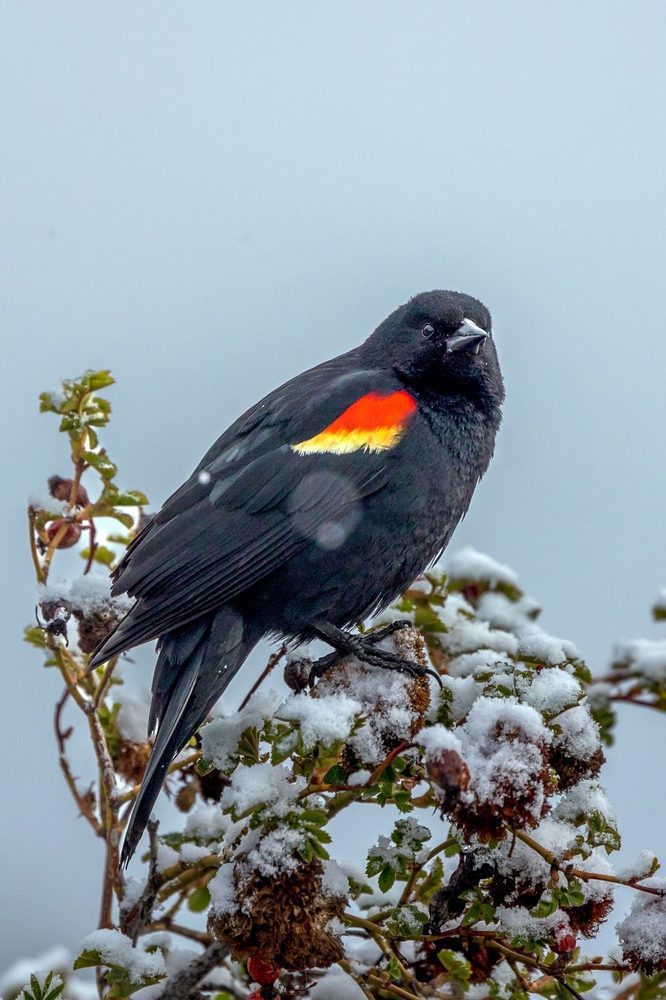
The Red-winged Blackbird (Agelaius phoeniceus) is a striking bird commonly found in North America. With its vibrant red and yellow shoulder patches, the male Red-winged Blackbird is easily recognizable. Let’s delve into the fascinating characteristics and behaviors of this beautiful feathered creature.
Appearance:
Males have a black body with distinctive red and yellow patches on their wings. Females, on the other hand, have a streaked brown appearance with a paler belly. The Red-winged Blackbird is approximately 7-9 inches long, making it a medium-sized bird. The beak of the Red-winged Blackbird is pointed and sturdy, ideal for foraging and cracking open seeds.
Habitat and Range:
These birds are adaptable and can be found in a variety of habitats, including marshes, wetlands, meadows, and agricultural fields. Red-winged Blackbirds are native to North America and can be spotted throughout the United States and Canada.
Diet and Feeding Habits:
Red-winged Blackbirds have a diverse diet that includes both plant matter and insects. They primarily feed on seeds, grains, berries, and small invertebrates. These birds are often seen foraging near the ground or perched on vegetation, using their beaks to extract seeds or insects. They are particularly fond of areas with standing water, where they can also probe for aquatic invertebrates.
Breeding and Nesting:
The Red-winged Blackbird breeds during the spring and summer months. Males establish territories in marshes or wetlands and build nests made of grasses, cattails, and other vegetation. These nests are usually positioned near water and are well-hidden among tall reeds. The males defend their territories vigorously, using their iconic calls to communicate and display their dominance. Females select mates based on the quality of the males’ territories.
Migration and Winter Habits:
Red-winged Blackbirds are considered short-distance migrants, with populations in the northern parts of their range migrating south for the winter. Outside of the breeding season, these birds gather in large flocks, often mixing with other blackbird species.
10. White-breasted Nuthatch

The White-breasted Nuthatch (Sitta carolinensis) is a small, yet distinctive bird commonly found in North America. With its black head, white face, and gray-blue back, this charming bird stands out among the crowd. Let’s explore some fascinating facts about this unique bird species.
Appearance :
The White-breasted Nuthatch measures around 5 to 6 inches (13 to 15 centimeters) in length, making it a relatively small bird. It has a black cap on its head, a white face, and a long, slender black beak. The back of the bird is a beautiful blue-gray color, which adds to its visual appeal. Its belly is white, and it has short wings and a relatively long tail.
Habitat and Behavior:
White-breasted Nuthatches are primarily woodland birds, preferring deciduous forests and mixed woodlands. They are known for their unique way of moving along the trunks and branches of trees. They often hop downwards head-first, using their strong claws to grip the bark. Nuthatches have a distinct “yank-yank” call that is loud and nasal-like, helping birdwatchers identify their presence. These birds are often seen foraging on tree trunks and branches, searching for insects, nuts, and seeds.
Feeding Habits:
White-breasted Nuthatches have a diverse diet that includes insects, spiders, and their eggs, as well as various seeds and nuts. They use their strong beaks to crack open seeds and extract insects from bark crevices. These birds are known for their habit of stashing food. They tuck acorns, seeds, and nuts into tree bark or crevices, creating a reliable food source for later.
Breeding and Nesting:
White-breasted Nuthatches form monogamous pairs during the breeding season. The female builds the nest in a tree cavity, which may be a natural cavity or an abandoned woodpecker hole. The nest is usually lined with bark flakes, feathers, fur, and other soft materials to provide comfort and insulation. During incubation, which lasts about two weeks, both parents take turns sitting on the eggs. Once the chicks hatch, both parents are responsible for feeding and caring for the young.
11. House Finch
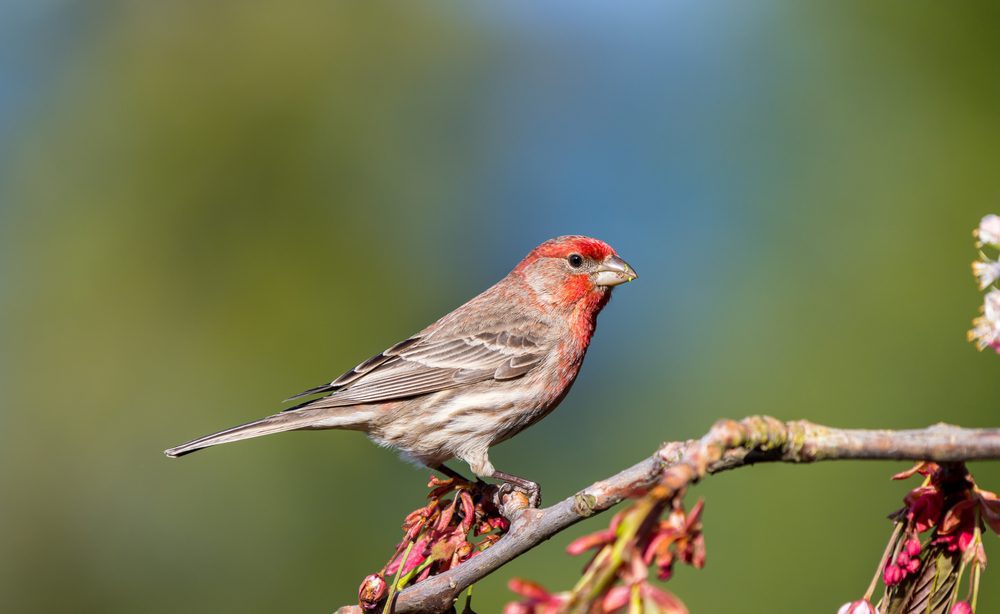
The House Finch (Haemorhous mexicanus) is a small bird that is native to North America. It is commonly found in the United States and parts of Canada. With its vibrant colors and cheerful song, the House Finch is a beloved visitor to many backyard bird feeders.
Appearance :
The House Finch measures about 5 to 6 inches in length. The male House Finch has a reddish coloration on the head, breast, and rump, while the rest of the body is brown or gray. The female House Finch, on the other hand, has a streaked brown appearance. Both male and female House Finches have a short, pointed beak that is adapted for cracking seeds.
Habitat and Range:
House Finches are adaptable birds that can be found in a variety of habitats, including urban areas, forests, and grasslands. They are often seen in open areas near trees or shrubs where they can build their nests. House Finches are native to the western United States and Mexico. However, they have been introduced to other parts of North America, including the eastern United States. Their range expansion can be attributed to their ability to adapt to a wide range of habitats.
Feeding Habits:
The House Finch primarily feeds on seeds, including those from sunflowers, dandelions, and other plants. They are also known to eat insects, especially during the breeding season when they need additional protein for their growing chicks. House Finches are frequent visitors to bird feeders, particularly those that offer sunflower seeds. They are often seen perched on platform feeders or clinging to tube feeders to access their favorite food.
Behavior and Song:
House Finches are social birds that often gather in flocks, especially during the non-breeding season. They are known for their melodious and cheerful song, which consists of a mixture of whistles and warbles. House Finches build cup-shaped nests using twigs, grass, and other plant materials. They often choose protected areas such as tree branches, ledges, or in the hanging baskets of porches. House Finches breed from spring to early summer, with males engaging in courtship displays such as singing and puffing up their colorful plumage to attract
12. American Crow

The American Crow (Corvus brachyrhynchos) is a highly intelligent and adaptable bird species found across North America. With its distinctive all-black plumage, sturdy build, and cawing call, the American Crow is a familiar sight and sound in both urban and rural environments. Let’s explore some fascinating facts about this remarkable bird.
Appearance:
The American Crow is approximately 17 to 21 inches long, making it a large bird in the crow family. It has black feathers, a stout bill, and strong legs. Its wingspan can reach up to 39 inches. One identifying feature of the American Crow is its shiny black plumage, which distinguishes it from similar species like the Fish Crow.
Habitat and Range:
American Crows are highly adaptable birds and can be found in a variety of habitats, including forests, fields, towns, and cities. They are native to North America and can be seen throughout the United States, Canada, and parts of Mexico. These birds prefer open areas with a mix of trees for nesting and perching.
Behavior and Intelligence:
Known for their remarkable intelligence, crows are among the most intelligent of all bird species. American Crows are highly social and form large flocks, especially during the non-breeding season. These flocks often gather in communal roosts, where hundreds or even thousands of crows spend the night together. They have a wide range of vocalizations, including their well-known “caw” call, which is used for communication within the flock and to warn of potential threats.
Diet and Feeding Habits:
American Crows have an omnivorous diet and can eat a wide variety of food items. They consume insects, small mammals, eggs, carrion, fruits, seeds, and even human food scraps. These clever birds are also known for their skills in using tools and methods to obtain food. For example, they may drop nuts or other hard objects onto hard surfaces to crack them open.
Conservation Status:
The American Crow is a common bird species and is not currently considered endangered or threatened. However, like many bird species, they can face certain threats such as habitat loss, pesticide exposure, and collisions with vehicles or buildings. Conservation efforts focused on protecting habitat and reducing these threats are important for maintaining healthy populations.
13. Song Sparrow

The Song Sparrow (Melospiza melodia) is a small bird that is commonly found in North America. With its distinctive melodic song, this bird is beloved by birdwatchers and beginner enthusiasts alike. Let’s explore the key characteristics, behavior, and habitat of the Song Sparrow.
Appearance:
The Song Sparrow measures around 5.5 to 7 inches (14 to 18 cm) in length. It has a plump body with a rounded head, short neck, and a stubby tail. The plumage of the Song Sparrow is generally brown or gray in color, with streaks and spots forming intricate patterns on its back and wings.
Melodious Song:
As the name suggests, the Song Sparrow is known for its beautiful and varied melodies. Each male Song Sparrow has its unique song, consisting of a combination of trills, warbles, and clear notes. The male Song Sparrow uses its melodious song to claim and defend its territory, attract mates, and communicate with other individuals.
Habitat and Range:
The Song Sparrow thrives in a variety of habitats, including grasslands, marshes, brushy areas, and forests. It is adaptable and can be found in both urban and rural environments. This sparrow species is widespread throughout North America, from Canada to Mexico, with different subspecies inhabiting various regions. Song Sparrows prefer areas with dense vegetation and shrubs, as they provide ample cover and nesting sites.
Diet and Feeding:
The Song Sparrow has an omnivorous diet, feeding on a wide range of seeds, fruits, berries, insects, and spiders. They are particularly fond of seeds like sunflower seeds and can frequently be seen visiting bird feeders. During breeding season, they also consume a significant amount of insects and larvae to provide essential protein for their growing chicks.
Nesting and Breeding:
Song Sparrows build their nests on or near the ground, often hidden in grasses or shrubs. The nests are cup-shaped and constructed using various materials such as twigs, leaves, grasses, and fine root fibers.
14. Northern Mockingbird
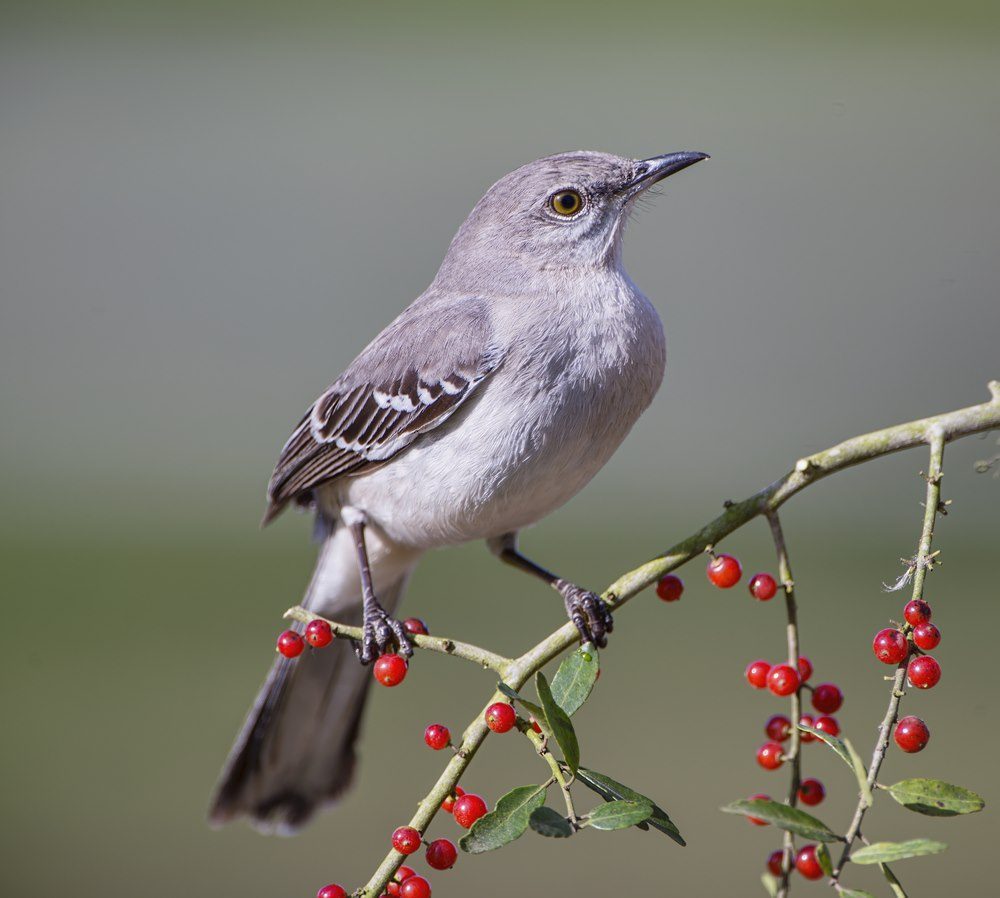
The Northern Mockingbird (Mimus polyglottos) is a species that has captivated bird enthusiasts and casual observers alike with its remarkable vocal abilities and adaptability. This bird, native to North America, is not only known for its melodious song but also for its distinctive appearance, behavior, and ecological significance.
Appearance:
The Northern Mockingbird is a medium-sized bird, measuring about 9 to 11 inches in length. It has a relatively slim build with long legs and a long tail. Its plumage is predominantly gray and white. The upper parts are mostly gray, while the underparts are lighter, often white. One of the most striking features of this bird is its wings and tail, which have white patches that are prominently visible during flight. The bird’s bill is slender and slightly curved, adapted for its varied diet.
Habitat
This bird is highly adaptable and can thrive in various habitats. It is commonly found in open areas with sparse vegetation, such as parks, gardens, and suburban areas. The Northern Mockingbird is also comfortable in agricultural and forest edge habitats. Its range extends throughout the United States, Mexico, and parts of Canada, with some populations migrating to the southern United States and Mexico during winter.
Behavior
The Northern Mockingbird is renowned for its vocal abilities. It can mimic the songs of other birds, and even sounds from its environment, such as car alarms. This mimicry is not just an auditory delight but also plays a role in territorial defense and attracting mates. Males are particularly vocal during the breeding season, often singing throughout the day and sometimes at night.
These birds are territorial and can be quite aggressive in defending their nesting area, often chasing away larger birds and even animals. During the breeding season, they are monogamous and both parents participate in raising the young.
Feeding Habits
The diet of the Northern Mockingbird is varied and includes insects, berries, and fruits. They forage on the ground, in shrubs, and on trees, adapting their diet based on the season and availability of food sources. Insects form a significant part of their diet during the summer, while berries and fruits are more common in their winter diet.
Conservation Status
Currently, the Northern Mockingbird is listed as Least Concern by the International Union for Conservation of Nature (IUCN). This status indicates that the species is widespread and abundant. However, like many bird species, it faces threats from habitat loss and fragmentation, pesticide use, and predation by domestic animals.
15. Red-bellied Woodpecker
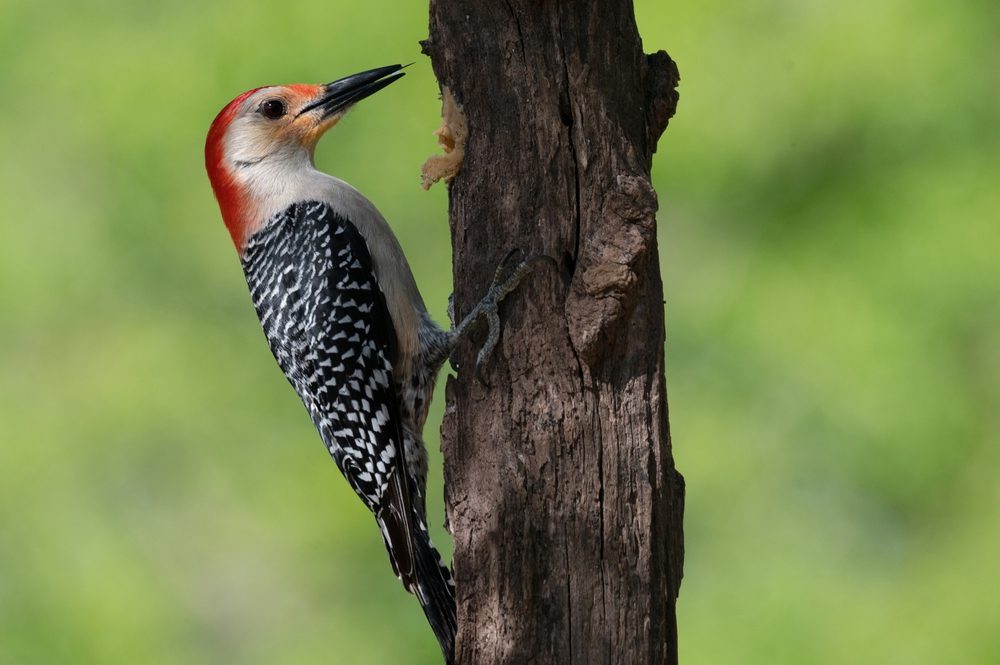
The Red-bellied Woodpecker (Melanerpes carolinus) is a striking bird that can add a vibrant touch to your backyard birdwatching experience. With its unique features and captivating behaviors, this medium-sized woodpecker is a treat to observe. Let’s delve into the fascinating world of the Red-bellied Woodpecker and explore why it’s a beloved species among bird enthusiasts.
Appearance :
The Red-bellied Woodpecker measures around 9 to 10 inches in length, making it a medium-sized woodpecker. Its identifying features include a black and white striped back, a black tail with white outer feathers, and a distinct red crown, which gives it its name. Despite its name, the red coloration on the belly of the Red-bellied Woodpecker is often hidden and not easily visible.
Habitat and Distribution:
Native to North America, the Red-bellied Woodpecker can be found in a wide range of habitats, including forests, woodland edges, and suburban areas. It is most commonly spotted in the eastern and southeastern regions of the United States, where it thrives in diverse ecosystems.
Feeding Habits:
The Red-bellied Woodpecker has an omnivorous diet, meaning it feeds on a variety of foods. It primarily eats insects, such as beetles, ants, and caterpillars, which it finds by excavating tree bark with its sturdy beak. In addition to insects, it also enjoys feasting on nuts, seeds, and fruits. You can attract Red-bellied Woodpeckers to your backyard by offering a mix of suet, peanuts, and sunflower seeds in a platform feeder.
Behavior and Vocalizations:
Red-bellied Woodpeckers are known for their drumming behavior, using their powerful beaks to create a rhythmic tapping sound on trees as a means of communication and establishing territory. Their vocalizations consist of a variety of calls, including a rolling churr and a distinctive “chik” or “queek” sound. These woodpeckers are skilled climbers, effortlessly moving up and down tree trunks in their quest for food.
Conservation and Protection:
Currently, the Red-bellied Woodpecker is listed as a species of “Least Concern” by the International Union for Conservation of Nature (IUCN). This status indicates that they are not currently at significant risk of extinction. However, like many wildlife species, they face threats from habitat loss and fragmentation due to human activities. Conservation efforts focusing on preserving and restoring their natural habitats are crucial for their continued survival.
Creating a Bird-Friendly Backyard
When it comes to attracting a variety of bird species to your backyard, creating a bird-friendly environment is essential. By incorporating certain elements into your outdoor space, you can provide a welcoming habitat for our feathered friends. Here are some key steps to help you transform your backyard into a haven for birds:
1. Choosing Native Plants:
Native plants are a crucial part of a bird-friendly landscape. They provide a natural food source, shelter, and nesting opportunities for many bird species. Consider planting a mix of trees, shrubs, and flowers that are native to your region. Native plants also attract insects, which are a vital source of food for birds, especially during breeding season.
2. Installing Bird Feeders:
Bird feeders can be a valuable addition to your backyard, attracting a wide range of bird species. When selecting feeders, opt for platform feeders or tube feeders that accommodate different bird sizes and feeding preferences. Fill them with high-quality birdseed, such as black oil sunflower seed, which is a favorite for many birds.
3. Providing Fresh Water:
Birds need water not only for drinking but also for bathing and preening their feathers. Including a bird bath or a shallow water feature in your backyard will attract birds and provide them with a reliable water source. Be sure to keep the water clean and change it regularly to prevent the spread of diseases.
4. Creating Shelter:
Birds seek shelter from extreme weather conditions and predators. By incorporating birdhouses, nesting boxes, or natural nesting spots into your backyard, you can encourage birds to stay and raise their young. Research the specific nesting requirements of the bird species in your area to ensure you provide suitable shelters.
5. Avoid the Use of Harmful Chemicals:
Pesticides, herbicides, and insecticides can be harmful to birds and the environment. Instead, opt for natural pest control methods and organic gardening practices. This will help maintain a healthy ecosystem in your backyard and ensure the well-being of your feathered visitors.
Key takeaway: Creating a bird-friendly backyard involves incorporating native plants, installing bird feeders, providing fresh water sources, creating shelter, and avoiding harmful chemicals. By taking these steps, you can attract a diverse range of bird species to your outdoor space and make a positive impact on their habitat.
Explanation: This section provides detailed information on how to create a bird-friendly backyard. It covers various aspects like choosing native plants, installing bird feeders,
Tips for Birdwatching in North America
tips for birdwatching in north america
Birdwatching, also known as birding, is a popular hobby for nature enthusiasts and wildlife lovers across North America. Whether you are a seasoned birder or a beginner looking to explore the fascinating world of birds, these tips will enhance your birdwatching experience:
1. Choose the Right Equipment:
Binoculars: Invest in a good pair of binoculars with a magnification power of at least 7x or 8x, and a wide field of view.
Field Guide: Carry a comprehensive field guide specific to the birds of North America, which will help you identify different species.
Smartphone Apps: Consider using birdwatching apps that provide bird calls, sighting records, and real-time information on bird locations.
2. Dress Appropriately:
Wear muted and comfortable clothing that blends into the natural surroundings. Neutral colors like khaki, beige, or olive green are ideal.
Opt for sturdy footwear suitable for walking on various terrains.
Don’t forget a hat, sunscreen, and insect repellent for added protection.
3. Visit the Right Locations:
Research and identify birding hotspots in your region. National parks, wildlife refuges, and nature reserves are often home to a diverse range of bird species.
Different habitats attract different birds. Explore forests, wetlands, grasslands, coastal areas, and urban parks for a variety of avian encounters.
4. Learn Bird Behaviors:
Observe and understand bird behaviors such as feeding, breeding, and migration patterns. This knowledge will help you anticipate their movements and locate them more easily.
Listen for bird calls and songs, as they provide valuable clues to their presence.
5. Practice Patience and Silence:
Birds are naturally wary and easily disturbed by loud noises or sudden movements. Remain quiet and still to avoid startling them.
Take your time to observe their behavior, and be prepared to wait patiently for the perfect sighting or photo opportunity.
6. Use Optimal Lighting:
The best times for birdwatching are early mornings and late afternoons when light conditions are softer. This lighting enhances the colors and details of the birds, making them easier to identify.
Avoid harsh midday sunlight, as it can create shadows and wash out colors.
7. Focus on Ecosystems:
Remember that birds are just one component of a larger ecosystem. Appreciate and observe the interactions between birds and their habitats, including their
19.Conclusion Common Backyard Birds
In conclusion, birdwatching is a fascinating and rewarding hobby that allows you to connect with nature and observe the beauty of our feathered friends up close. Throughout this blog post, we have explored the top 15 common backyard birds in North America, providing valuable information about each species and their distinctive features.
FAQ
What makes a bird common?
The definition of “common” can vary depending on the context, but generally it means there are a large number of individuals of that species present in a given area. Backyard birds, for example, are considered common if you see them frequently in your area.
What are some common bird problems in North America?
Some common bird problems in North America include drought, habitat loss, environmental toxins, and predator control.
How
There are many ways to get to know your backyard birds. You can use a bird identification guide, watch birds at a birding spot, or simply look for birds around your home.
How do I identify a bird by its song?
To identify a bird by its song, you will need to listen carefully and identify the different sounds it makes. Some of the most common sounds a bird makes are chirping, cooing, singing, and tweeting.
What should I do if I see a bird I don’t know in my backyard?
If you don’t know the scientific name of the bird you’ve seen, the best thing to do is to take a picture and post it to the National Audubon Society’s website (www.audubon.org). You can also contact your local bird club or park to ask for help identifying the bird.
What should I do if a bird is nesting in my backyard?
If you are in the backyard and see a bird nest, do not disturb the bird or its eggs. Birds build nests for many reasons, including to raise their young, to store food, or to find a safe place to rest. If you see a bird in your backyard, take a picture or record the information about the bird so you can report it to a bird conservation organization.
How do I create a bird-friendly backyard?
To create a bird-friendly backyard, start by clearing any debris and junk from your yard. This will make it easier to spot and study your backyard birds. Next, add a few bird feeders to your property. Make sure they’re located in areas where the birds can easily access them. Finally, create a bird bath or bird house and fill it with fresh water. This will attract a variety of backyard birds.
What are some tips for birdwatching in North America?
There is no one-size-fits-all answer to this question, as the best way to enjoy birdwatching in North America will vary depending on your location and the species of birds you are interested in observing. However, some general tips for birdwatching in North America include identifying the best time of year to view particular species, keeping an eye out for migratory birds, and becoming familiar with the habits and habitats of the common backyard birds in your area.
What are the top 15 backyard birds in North America?
Blue jay American crow Northern cardinal House Finch European starling Pine Siskin House Sparrow Brown Creeper American Goldfinch American Raven Barn Swallow Golden-crowned Kinglet Ruby-throated Hummingbird Black-chinned Hummingbird 15.

